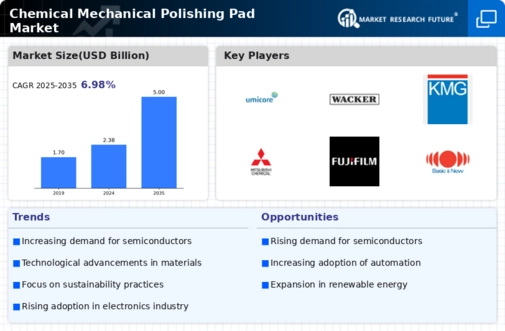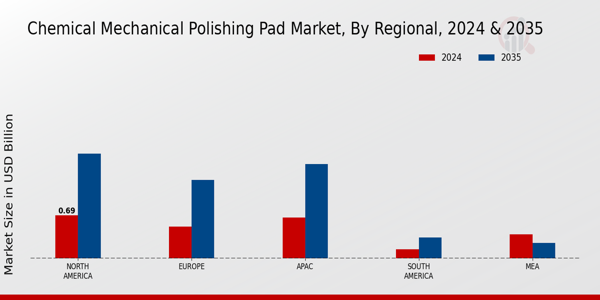Market Growth Projections
The Global Chemical Mechanical Polishing Pad Market Industry is projected to experience robust growth in the coming years. With a market value of 2.38 USD Billion in 2024, it is anticipated to reach 5 USD Billion by 2035. This growth trajectory indicates a strong demand for polishing pads across various applications, particularly in semiconductor and electronics manufacturing. The expected CAGR of 6.98% from 2025 to 2035 reflects the industry's resilience and adaptability to changing market dynamics. As technological advancements continue to emerge, the market is likely to evolve, presenting new opportunities for manufacturers and stakeholders.
Emerging Markets and Global Expansion
Emerging markets are becoming significant contributors to the Global Chemical Mechanical Polishing Pad Market Industry. Regions such as Asia-Pacific and Latin America are witnessing rapid industrialization and technological advancements, leading to increased demand for polishing pads. As global manufacturers expand their operations into these regions, the market is likely to experience substantial growth. The rising number of semiconductor fabs and electronics manufacturing facilities in these areas further supports this trend. Consequently, the market is poised for expansion, driven by the growing industrial base and the need for high-quality polishing solutions.
Growing Adoption in Electronics and Optics
The Global Chemical Mechanical Polishing Pad Market Industry benefits from the growing adoption of chemical mechanical polishing in electronics and optics. With the increasing miniaturization of electronic components, the need for precision polishing becomes critical. This trend is evident in the production of optical components, where surface quality directly impacts performance. The market is expected to expand as manufacturers seek to enhance product quality and meet stringent industry standards. As a result, the demand for specialized polishing pads tailored for these applications is likely to rise, further driving market growth in the coming years.
Sustainability and Environmental Regulations
Sustainability concerns and stringent environmental regulations are influencing the Global Chemical Mechanical Polishing Pad Market Industry. Manufacturers are increasingly focusing on eco-friendly materials and processes to comply with regulations and meet consumer expectations. The shift towards sustainable practices not only addresses environmental issues but also opens new market opportunities. Companies that invest in developing biodegradable or recyclable polishing pads may gain a competitive edge. This trend is expected to shape product offerings and drive innovation, as the industry adapts to changing regulatory landscapes and consumer preferences.
Rising Demand for Semiconductor Manufacturing
The Global Chemical Mechanical Polishing Pad Market Industry experiences a notable surge in demand driven by the semiconductor manufacturing sector. As the industry evolves, the need for advanced polishing techniques to achieve ultra-smooth surfaces on silicon wafers becomes paramount. In 2024, the market is projected to reach 2.38 USD Billion, reflecting the increasing complexity of semiconductor devices. This growth is further supported by the anticipated expansion of the semiconductor market, which is expected to double by 2035, reaching 5 USD Billion. The continuous innovation in chip technology necessitates high-performance polishing pads, thereby propelling the market forward.
Technological Advancements in Polishing Techniques
Technological advancements play a crucial role in shaping the Global Chemical Mechanical Polishing Pad Market Industry. Innovations in materials and manufacturing processes enhance the efficiency and effectiveness of polishing pads. For instance, the introduction of new polymer composites and nanotechnology has led to the development of pads that provide superior performance and longer lifespan. These advancements not only improve the quality of the polishing process but also reduce costs for manufacturers. As the industry moves towards more sophisticated applications, the demand for high-quality polishing pads is likely to increase, contributing to a projected CAGR of 6.98% from 2025 to 2035.












